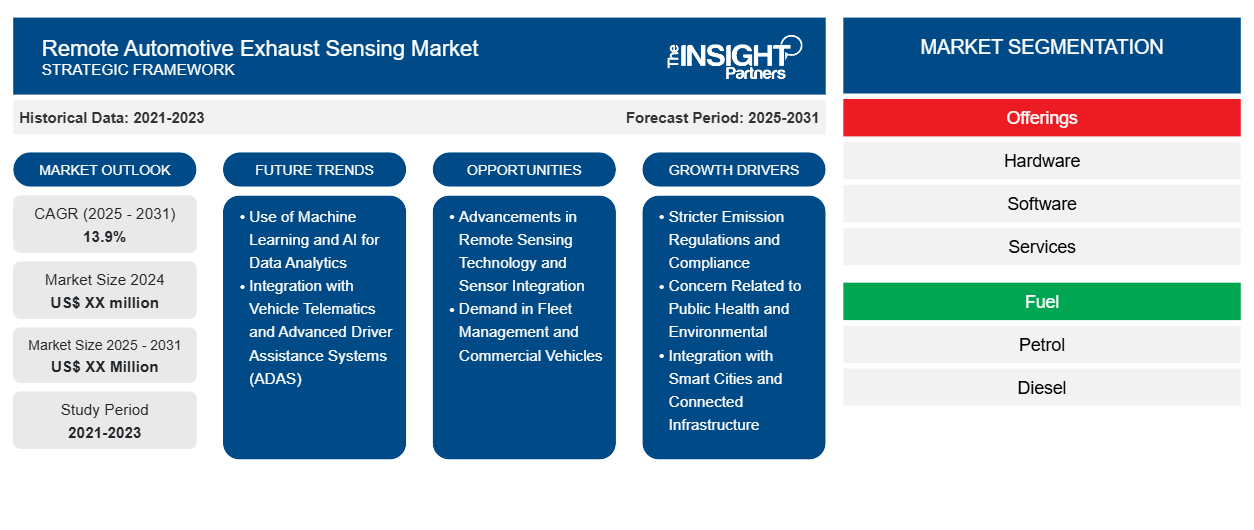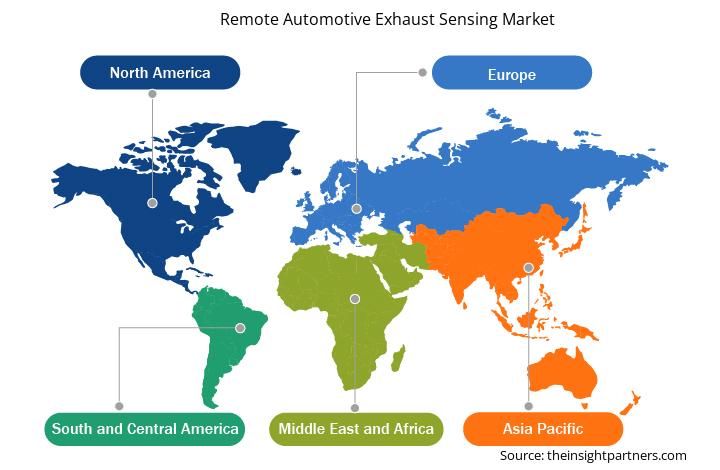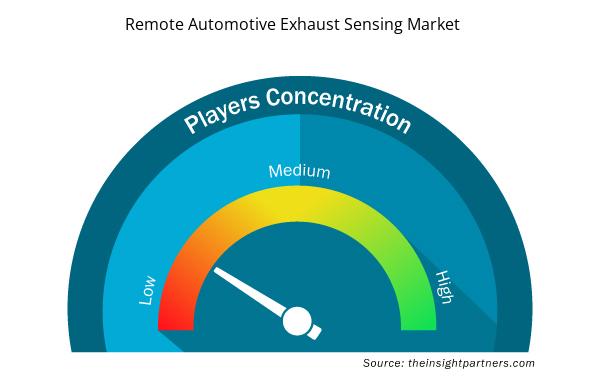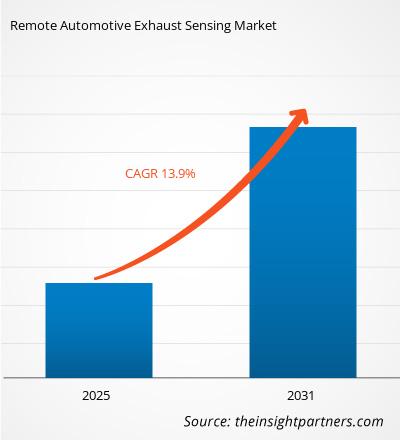The Remote Automotive Exhaust Sensing Market is expected to register a CAGR of 13.9% from 2025 to 2031, with a market size expanding from US$ XX million in 2024 to US$ XX Million by 2031.
The report is segmented by Offerings (Hardware, Software, Services); Fuel (Petrol, Diesel); Pollutants (Carbon Monoxide (CO), Carbon Dioxide (CO2), Nitrogen Oxide (NOx), Others). The report offers the value in USD for the above analysis and segments
Purpose of the Report
The report Remote Automotive Exhaust Sensing Market by The Insight Partners aims to describe the present landscape and future growth, top driving factors, challenges, and opportunities. This will provide insights to various business stakeholders, such as:
- Technology Providers/Manufacturers: To understand the evolving market dynamics and know the potential growth opportunities, enabling them to make informed strategic decisions.
- Investors: To conduct a comprehensive trend analysis regarding the market growth rate, market financial projections, and opportunities that exist across the value chain.
- Regulatory bodies: To regulate policies and police activities in the market with the aim of minimizing abuse, preserving investor trust and confidence, and upholding the integrity and stability of the market.
Remote Automotive Exhaust Sensing Market Segmentation
Offerings
- Hardware
- Software
- Services
Fuel
- Petrol
- Diesel
Pollutants
- Carbon Monoxide
- Carbon Dioxide
- Nitrogen Oxide
Geography
- North America
- Europe
- Asia Pacific
- Middle East and Africa
- South and Central America
Customize This Report To Suit Your Requirement
You will get customization on any report - free of charge - including parts of this report, or country-level analysis, Excel Data pack, as well as avail great offers and discounts for start-ups & universities
Remote Automotive Exhaust Sensing Market: Strategic Insights

- Get Top Key Market Trends of this report.This FREE sample will include data analysis, ranging from market trends to estimates and forecasts.
Remote Automotive Exhaust Sensing Market Growth Drivers
- Stricter Emission Regulations and Compliance: Governments worldwide are implementing stricter emission regulations for vehicles to combat air pollution and meet environmental goals. For instance, the Euro 6 standards in Europe and EPA regulations in the U.S. require vehicles to meet specific thresholds for carbon monoxide (CO), nitrogen oxides (NOx), and particulate matter (PM) emissions. These regulations necessitate more accurate, real-time monitoring of vehicle emissions, driving demand for advanced remote exhaust sensing technologies. Traditional methods of measuring exhaust emissions often require stationary setups or direct access to the vehicle's exhaust system. However, remote sensing technologies enable continuous monitoring without the need for direct vehicle interaction, making it easier for regulatory authorities and environmental agencies to ensure compliance.
- Concern Related to Public Health and Environmental: The growing awareness of the detrimental effects of vehicle emissions on public health and the environment is a significant driver of the market. Vehicle emissions are a major source of urban air pollution, contributing to issues like respiratory diseases, cardiovascular problems, and climate change. Governments and environmental organizations are under increasing pressure to reduce the levels of pollutants released into the atmosphere. Remote sensing technologies provide a convenient solution to continuously monitor and control emissions from vehicles, helping to address the growing environmental and health concerns. This, in turn, fuels demand for more widespread implementation of remote automotive exhaust sensing technologies.
- Integration with Smart Cities and Connected Infrastructure: As cities around the world transition to smart cities, the integration of IoT technologies and connected infrastructure presents a significant opportunity for remote automotive exhaust sensing. In smart cities, real-time traffic monitoring and environmental sensors are already becoming increasingly integrated to manage urban pollution and optimize traffic flow. Remote exhaust sensing systems can be integrated with this broader ecosystem, enabling real-time air quality monitoring in urban areas and pollution hotspots. This integration would allow authorities to monitor vehicle emissions continuously and enforce environmental standards more effectively. Moreover, as cities develop more connected road networks, exhaust sensors can provide data to urban planners and policymakers to optimize traffic patterns, identify high-pollution zones, and take timely corrective actions to reduce emissions.
Remote Automotive Exhaust Sensing Market Future Trends
- Use of Machine Learning and AI for Data Analytics: The integration of machine learning (ML) and artificial intelligence (AI) with remote sensing technologies is becoming an important trend in the automotive emissions market. AI algorithms can process vast amounts of data collected by remote exhaust sensors to identify trends, optimize vehicle performance, and predict potential emissions-related issues. These technologies enable predictive maintenance, helping to detect faults or inefficiencies in the vehicle’s emission system before they lead to significant problems or fines. Additionally, AI-driven analytics can be used to optimize fleet management by monitoring emissions levels across multiple vehicles in real time and making data-driven decisions to improve efficiency and sustainability.
- Integration with Vehicle Telematics and Advanced Driver Assistance Systems (ADAS): A growing trend is the integration of remote exhaust sensing systems with vehicle telematics and advanced driver assistance systems (ADAS). By combining exhaust sensing data with telematics systems, which track vehicle location, speed, and fuel efficiency, operators can gain a more comprehensive view of vehicle performance and environmental impact. This integration also supports real-time diagnostics and remote monitoring of emissions, providing instant feedback to drivers and fleet managers about the status of emissions systems. Additionally, in the context of ADAS, exhaust sensors can complement other sensors (such as those for air quality monitoring) to help create safer, more sustainable driving environments by providing feedback to drivers or guiding them to less polluted areas.
Remote Automotive Exhaust Sensing Market Opportunities
- Advancements in Remote Sensing Technology and Sensor Integration: The development of advanced sensor technologies is a major driver for the growth of the remote automotive exhaust sensing market. Innovations in optical sensing, infrared spectroscopy, and laser-based measurement techniques allow for the non-invasive detection of harmful gases in vehicle exhausts. These sensors can measure emissions from a distance, providing accurate data without interrupting vehicle operation. Additionally, the integration of IoT (Internet of Things) technologies into exhaust sensing systems allows for real-time data collection, remote diagnostics, and continuous monitoring of emissions, further enhancing their utility in fleet management, regulatory compliance, and environmental monitoring. As these technologies become more advanced and cost-effective, they offer a scalable solution for vehicle emissions monitoring, making them increasingly popular.
- Demand in Fleet Management and Commercial Vehicles: The fleet management sector represents a significant opportunity for remote automotive exhaust sensing. Fleet operators and logistics companies are under increasing pressure to comply with stringent environmental regulations and reduce the carbon footprint of their operations. Remote exhaust sensing can help fleet managers monitor emissions from multiple vehicles in real-time without requiring on-site inspections or manual checks. By implementing remote sensing technologies, fleets can ensure compliance with regulations, optimize vehicle performance, and reduce operational costs related to emissions fines or engine inefficiencies. Additionally, this technology provides an opportunity to enhance vehicle maintenance, optimize fuel efficiency, and contribute to sustainability goals by detecting potential emission control system failures early on.
Remote Automotive Exhaust Sensing Market Regional Insights
The regional trends and factors influencing the Remote Automotive Exhaust Sensing Market throughout the forecast period have been thoroughly explained by the analysts at Insight Partners. This section also discusses Remote Automotive Exhaust Sensing Market segments and geography across North America, Europe, Asia Pacific, Middle East and Africa, and South and Central America.

- Get the Regional Specific Data for Remote Automotive Exhaust Sensing Market
Remote Automotive Exhaust Sensing Market Report Scope
| Report Attribute | Details |
|---|---|
| Market size in 2024 | US$ XX million |
| Market Size by 2031 | US$ XX Million |
| Global CAGR (2025 - 2031) | 13.9% |
| Historical Data | 2021-2023 |
| Forecast period | 2025-2031 |
| Segments Covered |
By Offerings
|
| Regions and Countries Covered | North America
|
| Market leaders and key company profiles |
Remote Automotive Exhaust Sensing Market Players Density: Understanding Its Impact on Business Dynamics
The Remote Automotive Exhaust Sensing Market market is growing rapidly, driven by increasing end-user demand due to factors such as evolving consumer preferences, technological advancements, and greater awareness of the product's benefits. As demand rises, businesses are expanding their offerings, innovating to meet consumer needs, and capitalizing on emerging trends, which further fuels market growth.
Market players density refers to the distribution of firms or companies operating within a particular market or industry. It indicates how many competitors (market players) are present in a given market space relative to its size or total market value.
Major Companies operating in the Remote Automotive Exhaust Sensing Market are:
- Opus Group AB
- Hager Environmental & Atmospheric Technologies
- Doppler Environmental Protection Technology Co., Ltd.
- Anhui Baolong Environmental Protection Technology Co., Ltd.
- Korea Environment Corporation
- Hangzhou Chunlai Technology Co., Ltd.
Disclaimer: The companies listed above are not ranked in any particular order.

- Get the Remote Automotive Exhaust Sensing Market top key players overview
Key Selling Points
- Comprehensive Coverage: The report comprehensively covers the analysis of products, services, types, and end users of the Remote Automotive Exhaust Sensing Market, providing a holistic landscape.
- Expert Analysis: The report is compiled based on the in-depth understanding of industry experts and analysts.
- Up-to-date Information: The report assures business relevance due to its coverage of recent information and data trends.
- Customization Options: This report can be customized to cater to specific client requirements and suit the business strategies aptly.
The research report on the Remote Automotive Exhaust Sensing Market can, therefore, help spearhead the trail of decoding and understanding the industry scenario and growth prospects. Although there can be a few valid concerns, the overall benefits of this report tend to outweigh the disadvantages.
- Historical Analysis (2 Years), Base Year, Forecast (7 Years) with CAGR
- PEST and SWOT Analysis
- Market Size Value / Volume - Global, Regional, Country
- Industry and Competitive Landscape
- Excel Dataset



Report Coverage
Revenue forecast, Company Analysis, Industry landscape, Growth factors, and Trends

Segment Covered
This text is related
to segments covered.

Regional Scope
North America, Europe, Asia Pacific, Middle East & Africa, South & Central America

Country Scope
This text is related
to country scope.
Frequently Asked Questions
Some of the customization options available based on the request are an additional 3–5 company profiles and country-specific analysis of 3–5 countries of your choice. Customizations are to be requested/discussed before making final order confirmation# as our team would review the same and check the feasibility
The report can be delivered in PDF/PPT format; we can also share excel dataset based on the request
Use of machine learning and AI for data analytics and integration with vehicle telematics and advanced driver assistance systems (ADAS) is likely to remain a key trend in the market.
Stricter emission regulations and compliance, concern related to public health and environmental, and integration with smart cities and connected infrastructure are the major factors driving the remote automotive exhaust sensing market.
Global remote automotive exhaust sensing market is expected to grow at a CAGR of 10.6% during the forecast period 2024 - 2031.

 Get Free Sample For
Get Free Sample For